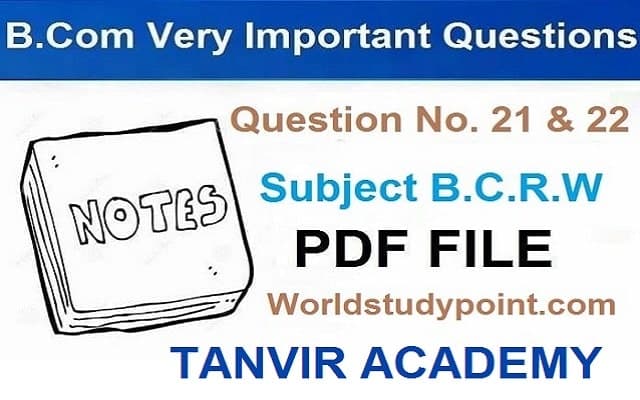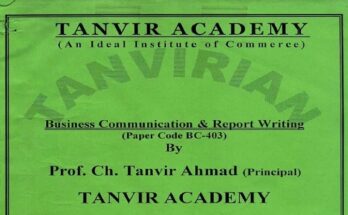Table of Contents
What are the kinds of informative and persuasive speaking?
INFORMATIVE SPEAKING:
Informative speaking is that the general purpose of which is to inform, whereas the
specific purpose depends upon the title of the speech.
Example:
| Title | Discipline |
| General Purpose | To inform |
| Specific purpose | Discipline in the class room |
KINDS OF INFORMATIVE SPEAKING
There are four kinds of informative speaking:
1. REPORTS:
The speaker has to read a periodical monthly or annual report on different areas relating
to business. Oral reports are boring for listeners because speakers do little to make their
statements interesting or work on clarity of organization.
The following lists summarize the most common forms of oral informative business
reports:
a) Periodic department reports
b) Progress reports on sales
c) Statements on area or division responsibilities
d) Reports on problems with vendors
e) Monthly personnel reports
2. GOODWILL
Here the main aim of an organization is to build goodwill and to develop a positive
company image in the community. Only good speakers who have considerable
knowledge on different topics are selected to represent the company to the public.
3. BRIEFINGS:
Briefing means short problem solving sessions. Usually, speaker gives background
information, current situation and options to deal with the problems. When you give
briefing on any topic then management will review your comments and make a
decision.
INSTRUCTIONS:
In this type of speech, you have to act as an instructor. You give instructions to
younger employees or new recruitment to the firm. The main goal is to clarify a
process or policy of the company.
PERSUASIVE SPEAKING
The general purpose of persuasive speech is to persuade the listeners to accept your
ideas or buy your products. Like informative speaking, persuasive speaking has a
specific purpose also.
1. POLICY:
It refers to a course of action to be taken or not to be taken. This speaking takes place in
response to question as the following:
→ What policy should we follow regarding investment in Lahore?
→ Which changes in policy does the board recommend in health care?
Your goal in answering a policy question is to arrive at a decision and then recommend
that decision to another person or group. To do that requires persuasion, supplying
reasons for accepting your recommendation.
2. PROCEDURE:
It refers to implementing the policy. The following questions suggest that a procedure
is requested:-
► How should we prepare for the court case?
In this speaking, the speaker persuades that one procedure is more desirable than
another is. The speaker has to stress on inadequacy of the previous system and benefits
of the new proposal.
► Give me a list of the better speakers in the organization.
A value judgment is needed to answer the questions above and react to the assertions.
4. FACT:
Everyone does not agree to what a fact is. The matters of fact should raise few
questions as to what is true. But not surprising, there are questions as to what happened,
when something occurred, or who did what?
Business questions and statements requiring a factual answer are presented in the
following:
► Your department has the highest absenteeism.
► Travel costs are way out of line; I want a report on last month’s expenditures.
Read Also : PPSC Tehsildar Test Preparation MCQs Full Book Download in PDF
INFORMATIVE SPEAKING:
We spend most of lives speaking to each other. Effective speaking is an important tool in a successful manager’s or supervisor’s kitbag. Speaking concerns all areas of activities in which we interact with
others.
But here we mean making a speech to group of people, small or large for the purpose of
informing any idea or persuading them for acceptance for our proposal, suggestion etc. So here
we are concerned about informative and persuasive speaking. For both types of speaking,
consider the following.
1. Purposes
2. Kinds
3. Audiences
4. Organization
1. PURPOSES:
Oral communication is basically used to inform, to persuade to entertain, etc. this is the general
purpose but when we aim at a precise objective we have a specific purpose.
EXAMPLE: Talking about discipline in our title. To inform is our general purpose. Discipline should go through three things; The title of the speech, the general purpose and the specific purpose
| Title | Discipline |
| General Purpose | To Inform |
| Specific purpose | Discipline in the office |
PROCESS OF PURPOSE:
Process means systematic steps to achieve the desired result. To achieve this objective, two
organizational formats are used chronological. (Step by step)
In chronological organization the speaker presents his point from beginning to ending in an
order.
EXAMPLE:
| Title | Language Teaching |
| General Purpose | To Educate |
| Specific Purpose | Tenses |
MAIN POINTS:
- i) Difference between time & tense.
- ii) Urdu equivalent of English sentences.
- iii) Syntax of sentences.
The topic organization is used if the process is complex or does not suit an order. In this case,
you can select the headings that gives only the main points of that process.
EXAMPLE:
| Title | Learning basic Grammar |
| General Purpose | To inform, to educate |
| Specific Purpose | To introduce students to the basic process of a learning English parts of speech. |
MAIN POINTS
i) Work Book.
ii) Different Passages.
iii) Transparencies.
iv) Overhead Projector.
Sometimes you have to make a speech to your employees clarifying the policies of the
organization. In this case visual aid can very helpful to your speeches.
PERSUASIVE SPECIFIC PURPOSES:
The basic purpose of the persuasive speech is to do the act of the advertisements do day and
night. Lake informative speaking, persuasive speaking too has a general and specific purpose.
Remember that persuasion is difficult so it needs more preparation to bring desired result.
EXAMPLE:
| Title | Decreasing Electricity Expenses. |
| General Purpose | To Persuade |
| Specific Purpose | To suggest different options for firm’s consideration and choose “Sensory Switches” as preferred one. |
Dear Mr. Faisal,
You will be glad to hear that we have found a new way to speed deliveries of fresh vegetables to you. From now on your product can reach you within two hours after we receive the order. We really feel sorry for the inconvenience caused by the delay. We have also transferred our delivery man since we receive the complaint from you. To make that the things are as you desire we will be in contact with you.
Yours truly,
XYZ
The Indirect Approach is used to convey bad news. Discuss with example.
INDIRECT APPROACH
INTRODUCTION:
Indirect approach is used when you feel that your message can cause some mental agony or
distress to the reader. In this sort of approach you do not blurt out your feelings abruptly rather
you first make some ground and make your listener feel your hidden intentions and then in the
end you go to the outburst of your actual feeling.
EXPLANATION:
The sender does not blurt out his feelings rather he first makes some grounds before
he pours out the message. In indirect approach the sender makes his reader smell the coming
news.
EFFECT OF DIRECT APPROACH:
This approach tends to win the sympathy of the receiver. It proves quite effective to pacify an
angry customer who has some serious complaints against the sender. It goes a long way in
retaining good relations with the receiver. Hence, it is really useful for a business organization.
RULE TO WRITE SUCH LETTER:
The rule to remember is to put the bad news in the middle”. Place a “buffer”, a cushion,
between the reader and the bad news by putting the bad news in the last paragraph position. This is the
indirect speech
WHEN TO USE:
► Refusing adjustments on claims and complaints.
► Refusing credit.
► Declining invitations and requests for favors.
SEQUENCE TO USE THE APPROACH
1. BUFFER:
Begin with something in the situation that you and the reader can ágree on. It may only
be that the reader was right to come to you with the problems. If there are no points of
agreements, pay the reader a compliment or say something friendly,
2. REASONS AND REFUSAL:
After the buffer paragraph, give the reasons for refusing orefor giving the bad news.
Begin with your best reason for refusal, go on to the next best, and so on.
3. POSITIVE ENDING:
By the end of the letter, you are past the rough parts. You can then offer a counter
proposal to what the reader asked or resell your point of view. Even a bad news
message should end on a hopeful note.
CONCLUSION:
In short, this approach is used to convey bad news messages. But it is
important that the tone of sender must be appropriate. The right attitude of
the sender can minimize the psychological tension of the reader.
SPECIMEN LETTER
Dear Sir,
We were surprised to hear that your sunshine electric fly pan needed servicing only three weeks
after you bought it. It has never happened before. Our service department examined your fry pan
carefully and found traces of detergent in the handle having heat control mechanism. This shows the
handle has been immersed completely in water which, is prohibited clearly in the instructions manual.
The manufacturer’s guarantee cannot apply in this case. We will have to bill you with the cost of the
repairs, which will be only Rs.75.
May we ask you, to be sure that you keep that handle out of water. If you observe the
instructions printed on the handle, we know you will have many years trouble free use of sunshine pan.
Yours sincerely,
X.Y.Z.





